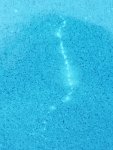We just had our pool resurfaced a few weeks ago. We had general issues with the install, including the initial trowel work was terrible and 20 other things. Entire surface was equivalent to 60 grit sandpaper. PB fixed most of that, with a lot of sanding (at our insistance), and an acid wash, as well as an acid start up.
Less than a week after our pool was filled, we started seeing these white lines. They have continued to get worse since then. The first 2 pics are a broader view of 2 different locations (these are in 1/2 the pool), the 3rd pic is a closer view of one of the lines - it was one of the first to appear, and seems to be spreading, for lack of a better way to describe it. I see the other ones doing the same.
PB was out, and has a number of things to fix. He claims this is normal crazing for any pool, and can be fixed with a stain, or color they can apply to it underwater.
Other info: water was trucked in. The pool did sit with the plaster on, no water for a few days while they tried to fix the surface texture (I was assured this would not be an issue).
I am concerned it indicates a different problem than normal crazing. I have read the info on calcium nodules, I am not sure those appear this quickly based on that, though. I am also dubious about a stain applied to the area to make the white lines go away.
Any thoughts/recommendations?
Pool chemistry has been monitored closely and within parameters since stabilization.



Less than a week after our pool was filled, we started seeing these white lines. They have continued to get worse since then. The first 2 pics are a broader view of 2 different locations (these are in 1/2 the pool), the 3rd pic is a closer view of one of the lines - it was one of the first to appear, and seems to be spreading, for lack of a better way to describe it. I see the other ones doing the same.
PB was out, and has a number of things to fix. He claims this is normal crazing for any pool, and can be fixed with a stain, or color they can apply to it underwater.
Other info: water was trucked in. The pool did sit with the plaster on, no water for a few days while they tried to fix the surface texture (I was assured this would not be an issue).
I am concerned it indicates a different problem than normal crazing. I have read the info on calcium nodules, I am not sure those appear this quickly based on that, though. I am also dubious about a stain applied to the area to make the white lines go away.
Any thoughts/recommendations?
Pool chemistry has been monitored closely and within parameters since stabilization.




